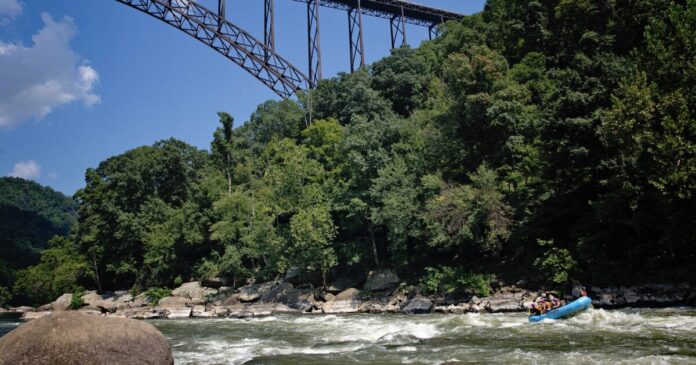While West Virginia is within driving range of a large percentage of the country, many visitors fly here.
Airports are often considered the cornerstone for the economic development and vitality of any region. As a key part of West Virginia’s transportation system, a viable airport network is the catalyst for state access to the national and worldwide marketplace.
With the advent of COVID-19 in 2020, the state began to see a shift from business to leisure travel. According to a study by tourism economic research firm Dean Runyan and Associates, the state’s “Almost Heaven” marketing campaign led to one of the most notable recoveries in the state’s tourism history.
The New River Gorge became a a national park and preserve in 2020. The following year, state and national parks enjoyed record-breaking attendance.
From white water rafting, to hiking, zip-lining, mountain biking, and winter skiing, West Virginia is recognized by Condé Nast Traveler, Lonely Planet, Luxury Travel and TIME Magazine as a leading global destination. Topping the list of most visited locations are:
- New River Gorge
- Harpers Ferry National Historical Park
- West Virginia State Museum
- West Virginia University
- The Kruger Street Toy & Train Museum
- Suspension Bridge
- State Capitol
- Berkeley Springs State Park
During the Governor’s Conference on Tourism in September, Gov. Jim Justice confirmed the state is enjoying an increase in visitors. In 2021 he said the state’s tourism industry experienced a 3.8 percent increase over pre-pandemic levels.
Justice said he believes West Virginia’s tourism economy could hit $5 billion this year for the first time in the state’s history. He said continued growth is dependent on reliable airport facilities.
“If you can’t get people here and get people to and from and you can’t get them there with some level of competitiveness like in other states, you’re really behind the eight ball,” he said. “To me you’re really splitting the bulls eye because airports are the heart of everything we have, I mean they really and truly are, as far as tourism especially.”
Early in 2020 the pandemic impacted the entire aviation industry and air travel nearly screeched to a halt. The state’s commercial service airports witnessed a far reaching reduction in scheduled airline service. The loss was compounded by a big drop in parking and landing fees, concessions revenues, user fees and fuel sales.
That’s all changed. In their 2021 Travel Impacts Study, research firm Dean Runyan and Associates reported visitors to West Virginia’s national parks spent $109 million.
“You know, we’ve made the right moves on the chess board, we’ve started promoting who we are, beyond that, we’ve upgraded our parks, we’ve done lots and lots of stuff,” Justice said. “It is really happening right now, and it is unbelievable.”
The governor said airports are critical to tourism but admitted to a deficiency in the state’s airport system. He said the state must remain competitive and invest in additional flight service.
“I believe in West Virginia beyond good sense and I see the opportunities,” he said. Right this minute tourism is exploding, but we’re still getting the parsley around the sides of the plate, there’s so much more to come. It’s off the charts.”
West Virginia’s airport system encompasses 24 publicly owned, public-use airports. Seven of those, including Yeager in Charleston; Huntington Tri-State and North Central West Virginia Airport near Clarksburg, are primary use, or commercial service airports.
All 24 airports are included in the Federal Aviation Administration’s (FAA’s) National Plan of Integrated Airport Systems (NPIAS).
Cindy Butler is the Commissioner of the West Virginia Department of Transportation’s new Division of Multimodal Transportation Facilities. In her role she oversees the aeronautics division which promotes air safety and helps airports secure state and federal funding. That includes matching grants through the aviation fuel tax for airport improvements.
“Aero in the past has historically been able to commit to half of whatever the federal match is,” Butler said. “Now as the grants get larger we don’t know that we’d be able to do the entire amount but as long as we’re getting the special fuel aviation tax in our special revenue fund we will continue to support our airports in any way we can.”
In a 2020 Aviation Economic Impact Study the Aeronautics Commission identified visitor spending as a primary economic benefit to West Virginia’s aviation system.
“We’re looking at about an average of 147,000 visitors through the seven commercial airports, basically saying that they would be the tourist type – looking at lodging spending, retail, local transportation, food and beverage and entertainment,” Butler said. “Probably about a $49 million spend, but the total impact of everything would be about $107 million when you look at all the other factors.”
In September West Virginia International Yeager Airport completed a runway rehabilitation project and more recently the FAA approved an environment study for an expansion of the facility and terminal. As the state’s busiest commercial service facility, Yeager offers flight service on American Airlines, Delta Air Lines, United Airlines, and Spirit Airlines. Passengers can fly nonstop to Charlotte; Philadelphia; Washington, D.C.; Chicago; Atlanta; Orlando; and Myrtle Beach. The airport is currently in active negotiations with the airlines to add additional flight service to Houston and Dallas.
Airport Director and CEO Dominique Ranieri says easier access fuels tourism spending.
“We know through multiple different studies and data points that visitors that come via air travel tend to stay longer and spend more money,” Ranieri said. “Making it easier to get to West Virginia will help the entire tourism economy and entire state.”
The airport is working with the Charleston Convention and Visitors Bureau to promote Charleston and the surrounding region and can now advertise attractions like white water rafting and skiing to visitors from the Orlando area which the airport offers flight service to through Spirit Airlines.
With the opening in April of the U.S. Customs and Border Protection General Aviation Facility, Yeager is now positioned as the only international port of entry in the state. The airport’s new Bill Noe Flight School is training future pilots at a time the industry faces a major pilot shortage.
With increased capacity and new flight service Ranieri said Yeager is a gateway that connects West Virginia to the national and worldwide marketplace.
“We are fortunate to be pretty centrally located here in Charleston to most of the attractions,” Ranieri said. “The New River Gorge National Park, we are kind of the gateway to that; it’s only an hour’s drive from here and in the winter your ski destinations are not far from here as well.”
The North Central West Virginia Airport in Harrison County boasts the largest commercial service runway in the state. Airport director Rick Rock says the airport was starting to make a comeback before COVID-19. He says new flight service will facilitate a current and projected future increase in visitor traffic.
“Our current terminal was built in 1960, it’s certainly served us well but it’s outlived its useful life, so in planning for that increased traffic we’re hoping to see a new terminal in place by the last quarter of 2024,” Rock said.
Rock says with airport upgrades, and more connectivity, travelers have easier access to destinations. Contour Airlines, which has served Parkersburg and Beckley since 2017, will replace SkyWest as their new Essential Air Service provider. As of Dec.1 flights to Chicago and Washington D.C. will use Charlotte as their singular hub, a move Rock expects to bring more people back to West Virginia. Allegiant Airlines offers flights to Florida and has plans to expand further.
West Virginia Secretary of Tourism Chelsea Ruby says since the launch of their “Almost Heaven” advertising campaign in 2018, the state has experienced rapid growth, exceeding pre-pandemic highs with annual traveler spending topping $611 million.
With West Virginia just an overnight’s drive for two thirds the state’s population, the focus has traditionally been on the drive market. But Ruby said attention is now on the state’s “fly market.”
“We went from the three hour drive radius to about a four and a half drive hour radius added into new markets,” Ruby said. “Since that time we’ve started looking at fly markets and started concentrating on areas like Charlotte, Chicago- places we have direct service.”
The department’s advertising assistance to its tourism partners and airports like Yeager is working to attract visitors. The hope is to encourage West Virginians to “fly local” – something Ruby says encourages airlines to add more flight service.
West Virginia Tourism is working with tour operators to attract visitors from the international market, with a focus on Canada and Europe. Ruby says visitors from Germany, in particular, love outdoor recreation and enjoy longer vacations.
“It seems like the Germans take longer road trips, they’re going to visit multiple states, so we seem to be a good fit for the German market and will continue to invest there.”










